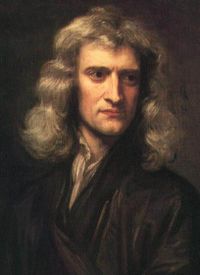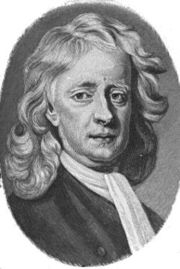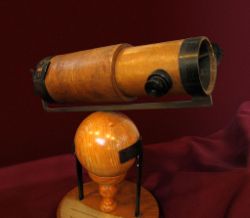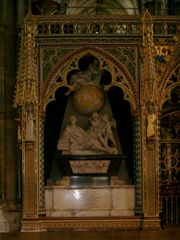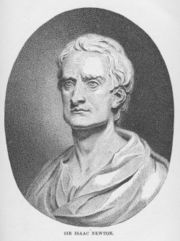Isaac Newton
2007 Schools Wikipedia Selection. Related subjects: Astronomers and physicists
| Isaac Newton | |
|---|---|
|
Sir Isaac Newton at 46 in Godfrey Kneller's 1689 portrait
|
|
| Born | 4 January 1643 [ OS: 25 December 1642] Woolsthorpe-by-Colsterworth, Lincolnshire, England |
| Died | 31 March 1727 [ OS: 20 March 1727] Kensington, London, England |
| Occupation | Physicist, mathematician, astronomer, alchemist, and natural philosopher |
Sir Isaac Newton, FRS ( 4 January 1643 – 31 March 1727) [ OS: 25 December 1642 – 20 March 1727] was an English physicist, mathematician, astronomer, alchemist, and natural philosopher, regarded by many as the greatest figure in the history of science. His treatise Philosophiae Naturalis Principia Mathematica, published in 1687, described universal gravitation and the three laws of motion, laying the groundwork for classical mechanics. By deriving Kepler's laws of planetary motion from this system, he was the first to show that the motion of objects on Earth and of celestial bodies are governed by the same set of natural laws. The unifying and deterministic power of his laws was integral to the scientific revolution and the advancement of heliocentrism.
In mechanics, Newton also markedly enunciated the principles of conservation of momentum and angular momentum. In optics, he invented the reflecting telescope and discovered that the spectrum of colours observed when white light passes through a prism is inherent in the white light and not added by the prism (as Roger Bacon had claimed in the thirteenth century). Newton notably argued that light is composed of particles. He also formulated an empirical law of cooling, studied the speed of sound, and proposed a theory of the origin of stars. In mathematics, Newton shares the credit with Gottfried Leibniz for the development of calculus. He also demonstrated the generalized binomial theorem, developed the so-called " Newton's method" for approximating the zeroes of a function, and contributed to the study of power series.
French mathematician Joseph-Louis Lagrange often said that Newton was the greatest genius who ever lived, and once added that he was also "the most fortunate, for we cannot find more than once a system of the world to establish." English poet Alexander Pope was moved by Newton's accomplishments to write the famous epitaph:
Nature and nature's laws lay hid in night;
God said "Let Newton be" and all was light.
Biography
Early years
| The life of Isaac Newton |
|---|
| Early life |
| Writing Principia |
| Later life |
| Religious views |
| Occult studies |
Newton was born at Woolsthorpe Manor in Woolsthorpe-by-Colsterworth, a hamlet in the county of Lincolnshire. He was born to a family of farmers who owned animals and land, thus making them fairly wealthy. The location he was born at was about seven miles from Grantham, where he later attended school. By his own later accounts, Newton was born prematurely and no one expected him to live; his mother Hannah Ayscough said that his body at that time could have fit inside a quart mug. His father, also named Isaac Newton, had been a yeoman farmer and had died three months before Newton's birth, at the time of the English Civil War. When Newton was three, his mother remarried and went to live with her new husband, leaving her son in the care of his maternal grandmother, Margery Ayscough.
According to E.T. Bell and H. Eves:
- Newton began his schooling in the village schools and was later sent to The King's School, Grantham, where he became the top boy in the school. At Kings, he lodged with the local apothecary, William Clarke and eventually became engaged to the apothecary's stepdaughter, Anne Storey, before he went off to Cambridge University at the age of 19. As Newton became engrossed in his studies, the romance cooled and Miss Storey married someone else. It is said he kept a warm memory of this love, but Newton had no other recorded "sweethearts" and never married.
However, Bell and Eves' sources for this claim, William Stukeley and Mrs. Vincent (the former Miss Storey - actually named Katherine, not Anne), merely say that Newton entertained "a passion" for Storey while he lodged at the Clarke house.
From the age of about twelve until he was seventeen, Newton was educated at The King's School, Grantham (where his signature can still be seen upon a library window sill). He was removed from school, and by October 1659, he was to be found at Woolsthorpe-by-Colsterworth, where his mother attempted to make a farmer of him. He was, by later reports of his contemporaries, thoroughly unhappy with the work. It appears to be Henry Stokes, master at the King's School, who persuaded his mother to send him back to school so that he might complete his education. This he did at the age of eighteen, achieving an admirable final report.
In June 1661, he was admitted to Trinity College, Cambridge. At that time, the college's teachings were based on those of Aristotle, but Newton preferred to read the more advanced ideas of modern philosophers such as Descartes and astronomers such as Galileo, Copernicus and Kepler. In 1665, he discovered the generalised binomial theorem and began to develop a mathematical theory that would later become calculus. Soon after Newton had obtained his degree in 1665, the University closed down as a precaution against the Great Plague. For the next 18 months Newton worked at home on calculus, optics and the law of gravitation.
Middle years
Mathematical research
Newton and Gottfried Leibniz developed calculus independently, using their own unique notations (as most great mathematicions do.) Although Newton had worked out his method years before Leibniz, he published almost nothing about it until 1693, and did not give a full account until 1704. Meanwhile, Leibniz began publishing a full account of his methods in 1684. Moreover, Leibniz's notation and "differential Method" were universally adopted on the Continent, and after 1820 or so, in the British Empire. Newton claimed that he had been reluctant to publish his calculus because he feared being mocked for it. Starting in 1699, other members of the Royal Society accused Leibniz of plagiarism, and the dispute broke out in full force in 1711. Thus began the bitter calculus priority dispute with Leibniz, which marred the lives of both Newton and Leibniz until the latter's death in 1716. This dispute created a divide between British and Continental mathematicians that may have retarded the progress of British mathematics by at least a century.
Newton is generally credited with the generalized binomial theorem, valid for any exponent. He discovered Newton's identities, Newton's method, classified cubic plane curves (polynomials of degree three in two variables), made substantial contributions to the theory of finite differences, and was the first to use fractional indices and to employ coordinate geometry to derive solutions to Diophantine equations. He approximated partial sums of the harmonic series by logarithms (a precursor to Euler's summation formula), and was the first to use power series with confidence and to revert power series. He also discovered a new formula for pi.
He was elected Lucasian professor of mathematics in 1669. In that day, any fellow of Cambridge or Oxford had to be an ordained Anglican priest. However, the terms of the Lucasian professorship required that the holder not be active in the church (presumably so as to have more time for science). Newton argued that this should exempt him from the ordination requirement, and Charles II, whose permission was needed, accepted this argument. Thus a conflict between Newton's religious views and Anglican orthodoxy was averted.
Optics
From 1670 to 1672, he lectured on optics. During this period he investigated the refraction of light, demonstrating that a prism could decompose white light into a spectrum of colours, and that a lens and a second prism could recompose the multicoloured spectrum into white light. He also showed that the coloured light does not change its properties, by separating out a coloured beam and shining it on various objects. Newton noted that regardless of whether it was reflected or scattered or transmitted, it stayed the same colour. Thus the colours we observe are the result of how objects interact with the incident already-coloured light, not the result of objects generating the colour. For more details, see Newton's theory of colour. Many of his findings in this field were criticized by later theorists, the most well-known being Johann Wolfgang von Goethe, who postulated his own colour theories.
From this work he concluded that any refracting telescope would suffer from the dispersion of light into colours, and invented a reflecting telescope (today known as a Newtonian telescope) to bypass that problem. By grinding his own mirrors, using Newton's rings to judge the quality of the optics for his telescopes, he was able to produce a superior instrument to the refracting telescope, due primarily to the wider diameter of the mirror. (Only later, as glasses with a variety of refractive properties became available, did achromatic lenses for refractors become feasible.) In 1671 the Royal Society asked for a demonstration of his reflecting telescope. Their interest encouraged him to publish his notes On Colour, which he later expanded into his Opticks. When Robert Hooke criticised some of Newton's ideas, Newton was so offended that he withdrew from public debate. The two men remained enemies until Hooke's death.
In one experiment, to prove that colour perception is caused by pressure on the eye, Newton slid a darning needle around the side of his eye until he could poke at its rear side, dispassionately noting "white, darke & coloured circles" so long as he kept stirring with "ye bodkin."
Newton argued that light is composed of particles, but he had to associate them with waves to explain the diffraction of light (Opticks Bk. II, Props. XII-L). Later physicists instead favoured a purely wavelike explanation of light to account for diffraction. Today's quantum mechanics restores the idea of " wave-particle duality", although photons bear very little resemblance to Newton's corpuscles (e.g., corpuscles refracted by accelerating toward the denser medium).
Newton is believed to have been the first to explain precisely the formation of the rainbow from water droplets dispersed in the atmosphere in a rain shower. Figure 15 of Part II of Book One of the Opticks shows a perfect illustration of how this occurs.
In his Hypothesis of Light of 1675, Newton posited the existence of the ether to transmit forces between particles. Newton was in contact with Henry More, the Cambridge Platonist who was born in Grantham, on alchemy, and now his interest in the subject revived. He replaced the ether with occult forces based on Hermetic ideas of attraction and repulsion between particles. John Maynard Keynes, who acquired many of Newton's writings on alchemy, stated that "Newton was not the first of the age of reason: he was the last of the magicians." Newton's interest in alchemy cannot be isolated from his contributions to science. (This was at a time when there was no clear distinction between alchemy and science.) Had he not relied on the occult idea of action at a distance, across a vacuum, he might not have developed his theory of gravity. (See also Isaac Newton's occult studies.)
In 1704 Newton wrote Opticks, in which he expounded his corpuscular theory of light. He considered light to be made up of extremely subtle corpuscles, that ordinary matter was made of grosser corpuscles and speculated that through a kind of alchemical transmutation "Are not gross Bodies and Light convertible into one another,...and may not Bodies receive much of their Activity from the Particles of Light which enter their Composition?" Newton also constructed a primitive form of a frictional electrostatic generator, using a glass globe (Optics, 8th Query).
Gravity and motion
In 1679, Newton returned to his work on mechanics, i.e., gravitation and its effect on the orbits of planets, with reference to Kepler's laws of motion, and consulting with Hooke and Flamsteed on the subject. He published his results in De Motu Corporum (1684). This contained the beginnings of the laws of motion that would inform the Principia.
The Philosophiae Naturalis Principia Mathematica (now known as the Principia) was published on 5 July 1687 with encouragement and financial help from Edmond Halley. In this work Newton stated the three universal laws of motion that were not to be improved upon for more than two hundred years. He used the Latin word gravitas (weight) for the force that would become known as gravity, and defined the law of universal gravitation. In the same work he presented the first analytical determination, based on Boyle's law, of the speed of sound in air.
With the Principia, Newton became internationally recognised. He acquired a circle of admirers, including the Swiss-born mathematician Nicolas Fatio de Duillier, with whom he formed an intense relationship that lasted until 1693. The end of this friendship led Newton to a nervous breakdown.
Later life
In the 1690s Newton wrote a number of religious tracts dealing with the literal interpretation of the Bible. Henry More's belief in the universe and rejection of Cartesian dualism may have influenced Newton's religious ideas. A manuscript he sent to John Locke in which he disputed the existence of the Trinity was never published. Later works — The Chronology of Ancient Kingdoms Amended (1728) and Observations Upon the Prophecies of Daniel and the Apocalypse of St. John (1733) — were published after his death. He also devoted a great deal of time to alchemy (see above).
Newton was also a member of the Parliament of England from 1689 to 1690 and in 1701, but his only recorded comments were to complain about a cold draft in the chamber and request that the window be closed.
Newton moved to London to take up the post of warden of the Royal Mint in 1696, a position that he had obtained through the patronage of Charles Montagu, 1st Earl of Halifax, then Chancellor of the Exchequer. He took charge of England's great recoining, somewhat treading on the toes of Master Lucas (and finagling Edmond Halley into the job of deputy comptroller of the temporary Chester branch). Newton became perhaps the best-known Master of the Mint upon Lucas' death in 1699, a position Newton held until his death. These appointments were intended as sinecures, but Newton took them seriously, retiring from his Cambridge duties in 1701, and exercising his power to reform the currency and punish clippers and counterfeiters. As Master of the Mint in 1717 Newton unofficially moved the Pound Sterling from the silver standard to the gold standard by creating a relationship between gold coins and the silver penny in the "Law of Queen Anne"; these were all great reforms at the time, adding considerably to the wealth and stability of England. It was his work at the Mint, rather than his earlier contributions to science, that earned him a knighthood from Queen Anne in 1705.
Newton was made President of the Royal Society in 1703 and an associate of the French Académie des Sciences. In his position at the Royal Society, Newton made an enemy of John Flamsteed, the Astronomer Royal, by prematurely publishing Flamsteed's star catalogue, which Newton had used in his studies.
Newton died in London on March 20th, 1727, and was buried in Westminster Abbey. His half-niece, Catherine Barton Conduitt, served as his hostess in social affairs at his house on Jermyn Street in London; he was her "very loving Uncle", according to his letter to her when she was recovering from smallpox. Although Newton, who had no children, had divested much of his estate onto relatives in his last years he actually died intestate. His considerable liquid estate was divided equally between his eight half-nieces and half-nephews (three Pilkingtons, three Smiths and two Bartons (including Catherine Barton Conduitt). Woolsthorpe Manor passed to his heir-in-law, a John Newton ("God knows a poor representative of so great a man"), who, after six years of "cock[fight]ing, horse racing, drinking and folly" was forced to mortgage and then sell the manor before dying in a drunken accident.
After his death, Newton's body was discovered to have had massive amounts of mercury in it, probably resulting from his alchemical pursuits. Mercury poisoning could explain Newton's eccentricity in late life.
Religious views
Although the laws of motion and universal gravitation became Newton's best-known discoveries, he warned against using them to view the universe as a mere machine, as if akin to a great clock. He said, "Gravity explains the motions of the planets, but it cannot explain who set the planets in motion. God governs all things and knows all that is or can be done."
His scientific fame notwithstanding, Newton's study of the Bible and of the early Church Fathers were among his greatest passions. He devoted more time to the study of the Scriptures, the Fathers, and to Alchemy than to science, and said, "I have a fundamental belief in the Bible as the Word of God, written by those who were inspired. I study the Bible daily." Newton himself wrote works on textual criticism, most notably An Historical Account of Two Notable Corruptions of Scripture. Newton also placed the crucifixion of Jesus Christ at 3 April, AD 33, which is now the accepted traditional date. He also attempted, unsuccessfully, to find hidden messages within the Bible (See Bible code). Despite his focus on theology and alchemy, Newton tested and investigated these ideas with the scientific method, observing, hypothesising, and testing his theories. To Newton, his scientific and religious experiments were one and the same, observing and understanding how the world functioned.
Newton may have rejected the church's doctrine of the Trinity. In a minority view, T.C. Pfizenmaier argues that he more likely held the Eastern Orthodox view of the Trinity rather than the Western one held by Roman Catholics, Anglicans, and most Protestants. In his own day, he was also accused of being a Rosicrucian (as were many in the Royal Society and in the court of Charles II).
In his own lifetime, Newton wrote more on religion than he did on natural science. He believed in a rationally immanent world, but he rejected the hylozoism implicit in Leibniz and Baruch Spinoza. Thus, the ordered and dynamically informed universe could be understood, and must be understood, by an active reason, but this universe, to be perfect and ordained, had to be regular.
Newton's effect on religious thought
Newton and Robert Boyle’s mechanical philosophy was promoted by rationalist pamphleteers as a viable alternative to the pantheists and enthusiasts, and was accepted hesitantly by orthodox preachers as well as dissident preachers like the latitudinarians. Thus, the clarity and simplicity of science was seen as a way to combat the emotional and metaphysical superlatives of both superstitious enthusiasm and the threat of atheism, and, at the same time, the second wave of English deists used Newton's discoveries to demonstrate the possibility of a "Natural Religion."
The attacks made against pre-Enlightenment "magical thinking," and the mystical elements of Christianity, were given their foundation with Boyle’s mechanical conception of the universe. Newton gave Boyle’s ideas their completion through mathematical proofs and, perhaps more important, was very successful in popularising them. Newton refashioned the world governed by an interventionist God into a world crafted by a God that designs along rational and universal principles. These principles were available for all people to discover, allowed man to pursue his own aims fruitfully in this life, not the next, and to perfect himself with his own rational powers.
Newton saw God as the master creator whose existence could not be denied in the face of the grandeur of all creation. But the unforeseen theological consequence of his conception of God, as Leibniz pointed out, was that God was now entirely removed from the world’s affairs, since the need for intervention would only evidence some imperfection in God’s creation, something impossible for a perfect and omnipotent creator. Leibniz's theodicy cleared God from the responsibility for " l'origine du mal" by making God removed from participation in his creation. The understanding of the world was now brought down to the level of simple human reason, and humans, as Odo Marquard argued, became responsible for the correction and elimination of evil.
On the other hand, latitudinarian and Newtonian ideas taken too far resulted in the millenarians, a religious faction dedicated to the concept of a mechanical universe, but finding in it the same enthusiasm and mysticism that the Enlightenment had fought so hard to extinguish.
Newton and the counterfeiters
As warden of the royal mint, Newton estimated that 20% of the coins taken in during The Great Recoinage were counterfeit. Counterfeiting was treason, punishable by death by drawing and quartering. Despite this, convictions of the most flagrant criminals could be extremely difficult to achieve; however, Newton proved to be equal to the task.
He gathered much of that evidence himself, disguised, while he hung out at bars and taverns. For all the barriers placed to prosecution, and separating the branches of government, English law still had ancient and formidable customs of authority. Newton was made a justice of the peace and between June 1698 and Christmas 1699 conducted some 200 cross-examinations of witnesses, informers and suspects. Newton won his convictions and in February 1699, he had ten prisoners waiting to be executed. He later ordered all records of his interrogations to be destroyed.
Newton's greatest triumph as the king's attorney was against William Chaloner. One of Chaloner's schemes was to set up phony conspiracies of Catholics and then turn in the hapless conspirators whom he entrapped. Chaloner made himself rich enough to posture as a gentleman. Petitioning Parliament, Chaloner accused the Mint of providing tools to counterfeiters (a charge also made by others). He proposed that he be allowed to inspect the Mint's processes in order to improve them. He petitioned Parliament to adopt his plans for a coinage that could not be counterfeited, while at the same time striking false coins. Newton was outraged, and went about the work to uncover anything about Chaloner. During his studies, he found that Chaloner was engaged in counterfeiting. He immediately put Chaloner on trial, but Mr Chaloner had friends in high places, and to Newton's horror, Chaloner walked free. Newton put him on trial a second time with conclusive evidence. Chaloner was convicted of high treason and hanged, drawn and quartered on March 23, 1699 at Tyburn gallows.
Enlightenment philosophers
Enlightenment philosophers chose a short history of scientific predecessors—Galileo, Boyle, and Newton principally—as the guides and guarantors of their applications of the singular concept of Nature and Natural Law to every physical and social field of the day. In this respect, the lessons of history and the social structures built upon it could be discarded.
It was Newton’s conception of the universe based upon Natural and rationally understandable laws that became the seed for Enlightenment ideology. Locke and Voltaire applied concepts of Natural Law to political systems advocating intrinsic rights; the physiocrats and Adam Smith applied Natural conceptions of psychology and self-interest to economic systems and the sociologists criticised the current social order for trying to fit history into Natural models of progress. Monboddo and Samuel Clarke resisted elements of Newton's work, but eventually rationalised it to conform with their strong religious views of nature.
Newton's laws of motion
The famous three laws of motion:
- Newton's First Law (also known as the Law of Inertia) states that an object at rest tends to stay at rest and that an object in uniform motion tends to stay in uniform motion unless acted upon by a net external force.
- Newton's Second Law states that an applied force, F, on an object equals the time rate of change of its momentum, p. Mathematically, this is written as
 Assuming the mass to be constant, the first term vanishes. Defining the acceleration to be
Assuming the mass to be constant, the first term vanishes. Defining the acceleration to be  results in the famous equation
results in the famous equation  which states that the acceleration of an object is directly proportional to the magnitude of the net force acting on the object and inversely proportional to its mass. In the MKS system of measurement, mass is given in kilograms, acceleration in metres per second squared, and force in newtons (named in his honour).
which states that the acceleration of an object is directly proportional to the magnitude of the net force acting on the object and inversely proportional to its mass. In the MKS system of measurement, mass is given in kilograms, acceleration in metres per second squared, and force in newtons (named in his honour). - Newton's Third Law states that for every action there is an equal and opposite reaction.
Newton's apple
A popular story claims that Newton was inspired to formulate his theory of universal gravitation by the fall of an apple from a tree. Cartoons have gone further to suggest the apple actually hit Newton's head, and that its impact somehow made him aware of the force of gravity. John Conduitt, Newton's assistant at the royal mint and husband of Newton's niece, described the event when he wrote about Newton's life:
In the year 1666 he retired again from Cambridge ... to his mother in Lincolnshire & whilst he was musing in a garden it came into his thought that the power of gravity (which brought an apple from a tree to the ground) was not limited to a certain distance from earth, but that this power must extend much further than was usually thought. Why not as high as the Moon said he to himself & if so, that must influence her motion & perhaps retain her in her orbit, whereupon he fell a calculating what would be the effect of that supposition... (King's College, Cambridge, Keynes Ms. 130.4: Conduitt's account of Newton's life at Cambridge (c.1727-8) )
The question was not whether gravity existed, but whether it extended so far from Earth that it could also be the force holding the moon to its orbit. Newton showed that if the force decreased as the inverse square of the distance, one could indeed calculate the Moon's orbital period, and get good agreement. He guessed the same force was responsible for other orbital motions, and hence named it "universal gravitation".
A contemporary writer, William Stukeley, recorded in his Memoirs of Sir Isaac Newton's Life a conversation with Newton in Kensington on 15 April 1726, in which Newton recalled "when formerly, the notion of gravitation came into his mind. It was occasioned by the fall of an apple, as he sat in contemplative mood. Why should that apple always descend perpendicularly to the ground, thought he to himself. Why should it not go sideways or upwards, but constantly to the earth's centre." In similar terms, Voltaire wrote in his Essay on Epic Poetry (1727), "Sir Isaac Newton walking in his gardens, had the first thought of his system of gravitation, upon seeing an apple falling from a tree." These accounts are probably exaggerations of Newton's own tale about sitting by a window in his home ( Woolsthorpe Manor) and watching an apple fall from a tree.
Various trees are claimed to be "the" apple tree which Newton describes, the King's School, Grantham, claims that the tree was purchased by the school, uprooted and transported to the headmaster's garden some years later, the staff of the [now] National Trust-owned Woolsthrope Manor dispute this, and claim that a tree present in their gardens is the one described by Newton. It is also claimed that the tree was replanted in front of the council buildings in Grantham, which is unlikely, considering that they were built over 300 years after Newton's death. A descendant of the original tree can be seen growing outside the main gate of Trinity College, Cambridge, below the room Newton lived in when he studied there.
Writings by Newton
- Method of Fluxions (1671)
- De Motu Corporum in Gyrum (1684)
- Philosophiae Naturalis Principia Mathematica (1687)
- Opticks (1704)
- Reports as Master of the Mint (1701-1725)
- Arithmetica Universalis (1707)
- An Historical Account of Two Notable Corruptions of Scripture (1754)
- Short Chronicle, The System of the World, Optical Lectures, The Chronology of Ancient Kingdoms, Amended and De mundi systemate were published posthumously in 1728.
